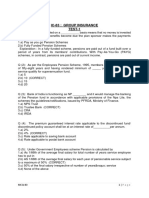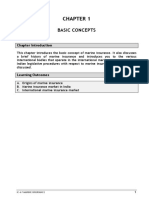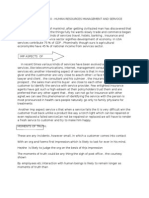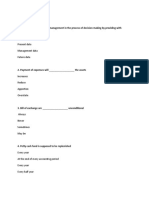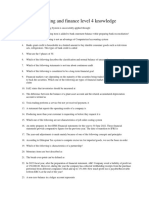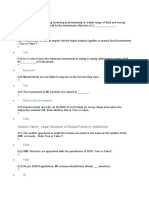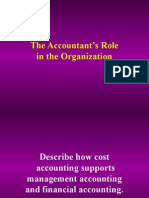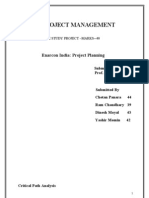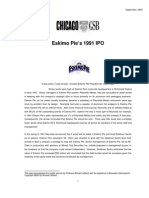IC 46 - One Word Q & A
IC 46 - One Word Q & A
Uploaded by
meatulCopyright:
Available Formats
IC 46 - One Word Q & A
IC 46 - One Word Q & A
Uploaded by
meatulOriginal Description:
Copyright
Available Formats
Share this document
Did you find this document useful?
Is this content inappropriate?
Copyright:
Available Formats
IC 46 - One Word Q & A
IC 46 - One Word Q & A
Uploaded by
meatulCopyright:
Available Formats
IC 46 GENERAL INSURANCE ACCOUNTS PREPARATION &
REGULATION OF INVESTMENT
1)
2)
3)
4)
5)
How much amount in General Insurance claim expenses is permissible?
General Insurance business consists of which type of claims?
___________________ Cost is acquisition cost.
What are the items included in acquisition cost?
What are the deductions can be made in commission paid and whom to
make it?
6) State the IRDA section regarding Commission?
7) Agency commission service tax included or excluded according to
_____________ guidelines.
8) According to IRDA, no payments are made in kind. It refers to the type of
which concept?
9) What is referred under section 40C, as per Insurance Act, 1938?
10) According to ___________ Regulation Act, ____________ must be
presented.
11) According to which Accounting Standard, the Revenue A/c Disclosure is
prepared?
12) The Final Accounts are audited by Statutory Auditors and they are
appointed by whom?
13) The Account which is prepared in local currencies are converted in
Indian currency as per which Accounting Standard?
14) In India only Annual basis is adopted for insurance for determination of
_______________ all departments of business including _______________,
_______________, ___________.
15) The financial statements and audit reports according to IRDA Act,
2002, protect the interests of whom?
16) Indian GAAP on Insurance Accounts comprises specific regulations
which include _______?
17) The schedule B with accounting regulations for preparation of financial
statements are belongs to which part?
18) Overview of Schedule B ______________.
19) What are the Accounting Standards as applicable in Schedule B part?
20) The provisions of Section 64 V(I) (II) B of the Insurance Act, 1938
reserve for unexpired risks shall be created in respect of
_________________.
21) What is meant by premium deficiency?
22)
Equity Securities and derivative instruments shall be measured in?
23) What do you understand by Catastrophe Reserves?
24) The disclosures forming part of financial statements are described
under which part?
25) Ageing of claims is?
26) Schedule B Part III dealt for _______________.
27) Schedule 3 refers to ______________.
28) What method loss shall be measured?
Page 1 of 9
IC 46 one word questions
29) An insurance company carrying on general insurance business is
required to prepare Balance Sheet, Revenue A/c and Profit & Loss A/c with
_____________.
30) For a company engaged in general insurance business premium is
recognised.
31) What are the sources of funds to an insurance company and state its
schedule numbers?
32) General insurance companies are required to prepare separate
revenue A/cs. What are they?
33) What is the percentage for apportionment of managerial expense?
34) What is the general rule to compute the cash flow statement by
indirect method?
35) What are the activities carried down in cash flow statement?
36) Profit after Tax /Net premium =
37) Gross commission paid / gross direct premium income
38) Ratio time ______________, growth ______________,
39) Accounting Principles, Accounting Standards, Accounting Process &
Accounting Conventions
40) Calculate Cash from operations:
Book profit Rs.1000/-; Depreciation Rs.500/-; Sale of fixed assets Rs.250/-;
increase inventories Rs.600/-; increase creditors Rs.600/-.
41) In India, insurance business is adopted under which basis?
42) What are the terms included in cost?
43) Increase current liabilities; decrease current assets; then, what aspect
in cash from operations?
44) Where the accounting ratio can be obtained from?
45) Non life insurance companies strong enough ratio is ________.
46) Which section of the Insurance Act deals with the preparation of
financial statements?
47) National Insurance Co. Ltd. given the following particulars related to
Reinsurance:
Commission received during the year 2014-15
=
Rs.30000
Commission receivable on 01st April 2014
=
Rs. 5000
Commission receivable on 31st March 2015
=
Rs. 2000
What amount will be shown in Revenue A/c?
48) A direct insurer assumes by way of primary insurance contract to a
second insurance carrier
called __________.
49) Role of insurance brokers is _____________.
50) Treaty reinsurance means ___________.
51) What is the formula for if profit commission is an additional
commission percentage payable to a ceding insurer?
52) Reinsurance arrangements are broadly divided into ___________.
53) A Plants useful life is 10 years. Depreciation amount of Rs.30 lakhs.
The company has changed depreciation under SLM. At the end 6 th year,
the balance useful life was re-estimated at 8 years.
How much
th
depreciation will be arrived from at the 7 year?
54) Non life insurance policy purchased on 24/03/2007 of US $ 100000, for
the Exchange rate on 31/03/2007 is Rs.47.00. Date on actual payment on
Page 2 of 9
IC 46 one word questions
05/06/2007 is Rs.47.50. Calculate the loss/gain for the financial years
2006-07 & 2007-08:
55) Government grants related to depreciable fixed assets to be treated as
deferred income which is to be recognised in the P&L account in
proportion to the Depreciation on those are changed over the useful life of
the asset. According to AS 12, the apportionment amount, deferred Govt.
grant which side it will appear in Balance Sheet after which head?
56) Investments are assets held for earning income, capital appreciation.
What you think investments held as stock-in-trade?
57) SBI Bank has classified its total investment on 31/03/2014 into three
categories (a) held to maturity (b) available for sale (c) held for trading.
Comment the policy of the bank.
58) New India Assurance Company have three type of investments on
31/03/2013 (a) maturity (b) available for sale (c) held for Trading. How it
will measure according to AS 13?
59) Financial Statement should disclose whether actuarial valuation is
made at the end of the accounting period?
60) Leave encashment is accounted for on Pay-As-You-Go method.
61) M Insurance Companys Interim Financial Report (IFR) quarterly:
Earned Rs.800 lakhs. Pre-tax profit in the quarter ending 30/06/2008. But
expect to incur losses of Rs.250 lakhs in each of the remaining three
quarters. Effective income tax rate is 35%. Calculate the income-tax
expense to be reported for 1st quarter as per AS 25 and total Tax expenses.
62) X Ltd. purchased Machinery on 01/01/2002 for Rs.20 lakhs. WDV of
the machinery on 31/03/2008 for Rs.28 lakhs. The recoverable amount of
the machine is Rs.11 lakhs. What is the impairment loss?
63) The business transactions are recorded first in the primary books of
accounts known as ___________.
64) Cash deposited into bank Rs.100000/-. What is the entry in cash
book?
65) Trading Account shows debit side higher balance. What is the result?
66) Profit & Loss Account Credit balance is transferred to where?
67) Which
accounting
standard
provides
segmentation
detailed
information?
68) All transactions are events; but all events are ____________.
69) Which account deals with expenses according to double entry system?
70) Earnings per share deals with which Accounting Standard?
71) How much percentage of reserve for unexpired risks?
72) Bank Reconciliation Statement is the statement prepared by an entity
that reconciles which balances?
73) Cheque issued but not presented for payment, which book it will be
added?
74) What is an effect of direct payments and remittances by bank
cheque?
75)
What is an effect in Cash Book on dishonour of bills?
76) Who shall be verified and certified for investment returns?
77) Who will give approval annually on investment policy?
78) Who will implement investment policy?
Page 3 of 9
IC 46 one word questions
79) What is the aim of the policy?
80) Who will be the members of the invest committee?
81) __________ Investment returns are to be submitted by every insurer to
the regulator.
82) What is the rating scale for short-term investment?
83) What is solvency margin?
84) What is nominal column?
85) In which column Income/Investment are posted?
86) What is the Profit Sale on investment from the following: Equity Shares
1000; Each Rs.100; Normal value Rs.400000; Capital value Rs.500000/-.
87) The right to issue share will be added to _________.
88) According to _______ Act ______ Section describes General Insurance
Companys Annual Report.
89) Annual Report contains information of ______, _________.
90) When the auditor provides a modified opinion, the opinion cannot be
________.
91) What type of audits, the insurance companies are normally conducted?
92) The main auditor submits the report to whom?
93) The true and Fact view of the report based on __________ accounts.
94) Financial Statements are said to be true, when they are?
95) Proper internal audit system and control will ensure that the financial
statement of an entity will exhibit _______.
96) An increase in interest rate is due to higher actual or anticipated
inflation __________ likely to increase.
97) From the following, What is the Trial Balance Total:
Sales Rs.100000/-; Purchase Rs.30000/-; Salary Rs.15000/-; Purchase
Return Rs.5000/-; Sales Return Rs.10000/-; Capital Rs.50000/-; Land
Rs.40000/-; Wages Rs.5000/-; Rent Paid Rs.10000/-; Furniture Rs.50000/-;
Machinery Rs.35000/-.
98) Minimum liability test involves ____________.
99) What are the methods acceptable under IFRS 9?
100) Under what circumstances can an entity classify financial assets that
meet the amortised cost criteria as at FVTPL?
BEST WISHES
TO YOU
ALL
Page 4 of 9
IC 46 one word questions
ANSWERS
1) 70
2) Accepted but not paid & claim intimated but not accepted and paid
3) Relation
4) Agents, Brokers, Corporate Agents, Bank under Bancassurance or all
intermediaries
5) ST & TDS paid to Govt. Account, Insurance commission
6) U/s IRDA 1999, 40(1), 40A(3), 42 E, Insurance Act, 1938
7) Excluded
8) Money measurement concept
9) Rs.5 lakhs Net premium whichever is higher
10)
As per IRDA, 2002 (FS)
11)
AS 01
12)
Shareholders Public Company, CAG in case of Government Company
(Page 422)
13)
AS 11 (Page 421)
14)
Underwriting Result
Miscellaneous (Page 424)
15)
Fire,
Marine,
Motor,
Engineering
and
Policyholder and all the stakeholders involved
16)
Insurance Act, 1938, Companies Act, 1956, AS issued by ICAI (Page
430)
17)
Part V for preparation of Financial Statements (Page 431)
18)
Part I, II, III, IV and V (Page 432)
19)
AS 3, AS 13 & AS 17
20)
Fire & Miscellaneous 50%; Marine Cargo 50%; Marine Hull 100% (Page
433)
21)
Related and Maintenance Costs exceed the related reserve for
unexpected risks (Page 434)
Page 5 of 9
IC 46 one word questions
22)
Fair value: The lowest of the last quoted closing price in stock market
securities list (Page 435)
23)
As prescribed by Authority (Page 436)
24)
Schedule B Part II (Page 438)
25)
O/s more than 6 months (Page 438)
26)
GI for preparation of FS (Page 441)
27)
Premium earned (not) (Page 451)
28)
Historical Cost subject to impairment provision (Page 483)
29)
Schedule B (Page 486)
30)
Over the contract period (or) period of risk (Page 483)
31)
Share capital Rs.5, Borrowing and fair value charge account 5,6,7
(Page 489)
32)
Fire, Marine and Miscellaneous (Page 492)
33)
75% and 100% (Page 494)
34)
NP + Non cash expenses non cash incomes (Page 523)
35)
Operating activities, investing activities and financial activities (Page
520)
36)
Give formula Net earnings ratio
37)
What is non commission ratio?
38)
Calculate Gross premium to shareholders fund ratio.
For the FY
Gross premium
Shareholder funds
2005-06
5675.54
4161.69
2004-05
5103.16
3735.22
39)
What are the legal aspects of GI Financial Accounting?
40)
600
Book profit 1000+500. Dep. + increased creditors 600 Income stock
2100 600 = 1500
41)
Only annual basis (Page 393)
42)
Incurred Claims Net, Commission Acquisition Cost, Operation expenses
(Page 396)
43)
Increase cash value (Page 521)
44)
Financial Statement (Page 526)
Page 6 of 9
IC 46 one word questions
45)
Solvency margin ratio (Page 534)
46)
Section II (Page 535)
47)
30000 + 5000 2000 = 33000
48)
Reinsurer
49)
An intermediary (Page 550)
50)
A treaty is an automatic re-insurance facility which covers portfolio of
risks (Page 554)
51)
An agreed formula (Page 588)
52)
Two (I) Facultative (II) Treaty
53)
(30 (30/10) *6) / 8 = 1.5
54)
AS 11; 100000 * 46.60 = 4660000; 100000 * 47 = 4700000
Exchange loss Rs.40000/- (4700000 4660000) in 2006-07
100000 * 47.50 = 4750000 4700000 = 50000 should be debited in P&L in
2007-08
55)
Liabilities side after R&S; But before Secure loan
56)
It is not in investment. It is current assets as per AS 13
57)
In Bank not applicable AS 13 only RBU Rule
58)
Held to maturity investment is carried at acquisition cost less amortise
amount. Available for sales are carried at market to market. Held for trading
investments are valued at weekly.
59)
Actuarial valuation and the method used for accrual period; if not
based on actuary report.
60)
As regard leave encashment which is accounted for on PAY AS YOU
GO basis. It is not in accordance with AS 15. It should be accounted on
accrual basis.
61)
1st quarter 800 x 35/100 = Rs.280 lakhs; Annual Tax expenses =
Rs.17.5 lakhs ( II quarter 250 x 35/100 = Rs.87.5 lakhs; 3 rd quarter 87.5 x 3 =
Rs.262.5 lakhs (280 262.50 lakhs)
62)
Impairment loss = carrying amount recoverable amount
12 lakhs 11 lakhs = 1 lakh
63)
Journals (6)
64)
Bank A/c Debit; Cash A/c Credit;
65)
Gross loss
Page 7 of 9
IC 46 one word questions
66)
Balance Sheet : Liability side Add: Capital or shown separately
67)
AS 17
68)
Transaction (Page 20)
69)
Nominal A/c
70)
AS 20
71)
100% Marine; 50% for other classes of business (Page 132)
72)
Pass Book and Cash Book (Page 253)
73)
Cash Book (Page 256)
74)
Less Cash Book (Page 256)
75)
Less Cash Book (Page 256)
76)
CEO / Chief of Investment (Page 610)
77)
Board of Directors (Pages 607, 610)
78)
Investment Committee (Pages 607, 610)
79)
Must ensure adequate return (Page 607)
80)
Minimum Two Non executive Director, CEO, Chief of Finance, Chief of
Investment decision and the appointed actuary (Page 606)
81)
Actuary (Page 605)
82)
A1, A2, A3, A4 and D1 (Page 600)
83)
Assets of an insurer liabilities
84)
Investment purchase; sold, bonus, etc. (Page 673)
85)
Cum Interest or Ex Interest received or receivable investment (Page
623)
86)
400000/500000 x 100000 = 80000
87)
Carrying amount of original holding (Page 642)
88)
1956, 217 (Page 648)
89)
Operation and Financial Performance
90)
True and Fair (Pages 658, 667)
91)
SA, IA, CA, OA UA and IA (Page 670)
92)
Statutory Auditor
93)
Income and P&L A/c (Page 700)
Page 8 of 9
IC 46 one word questions
94)
Factually correct (Page 701)
95)
A True and Fair view of profit or loss and state of affairs of the entity
(Page 748)
96)
Normal Cash outflows are likely to increase
97)
Rs.155000/-
98)
A comparison of recognised insurance liabilities against cash flows
(Page 815)
99)
Amortised cost and fair value (Page 816)
100) Where the investment is held to maturity (Page 816)
Page 9 of 9
You might also like
- Fundamentals of Management 10Th Edition Ricky Griffin Full ChapterDocument51 pagesFundamentals of Management 10Th Edition Ricky Griffin Full Chaptershannon.bush78994% (16)
- IC-27 Health PDFDocument240 pagesIC-27 Health PDFnic 55170075% (48)
- IC 76 Aviation InsuranceDocument264 pagesIC 76 Aviation InsuranceAneeshRaghavNo ratings yet
- Professional Examination PDFDocument35 pagesProfessional Examination PDFDeepak Gupta71% (7)
- Igcse Economics Notes 0455Document74 pagesIgcse Economics Notes 0455fifth193100% (1)
- IC 45 Underwriting III EbookDocument241 pagesIC 45 Underwriting III EbookAkshay Meena95% (21)
- Ic 27 Health Insurance PDF DownloadDocument1 pageIc 27 Health Insurance PDF DownloadMohit BiswalNo ratings yet
- IC-57 Fire and ConsequentialDocument312 pagesIC-57 Fire and ConsequentialAshish Keshan84% (38)
- Insurance Examination HandbookDocument99 pagesInsurance Examination Handbookanon_922969906No ratings yet
- Reinsurance Selected QsDocument17 pagesReinsurance Selected QsSonu RayNo ratings yet
- MCQ Ic 83Document83 pagesMCQ Ic 83Pratik ChahwalaNo ratings yet
- Ic 46 Book General Insurance Accounts Preparation and Regulation of InvestmentDocument823 pagesIc 46 Book General Insurance Accounts Preparation and Regulation of InvestmentDr. S100% (1)
- Ic 27 Health Insurance PDF DownloadDocument3 pagesIc 27 Health Insurance PDF Downloadharsha60% (5)
- Motor OD Manual - Underwriting & Calims PDFDocument201 pagesMotor OD Manual - Underwriting & Calims PDFMani Rathinam100% (2)
- IC-67 Marine InsuranceDocument294 pagesIC-67 Marine InsuranceAshish Keshan83% (18)
- Ic 14Document144 pagesIc 14rishu100% (1)
- IC-57 PaperDocument18 pagesIC-57 PaperTasleem Sayad33% (3)
- IC 92 Actuarial Aspects of Product DevelopmentDocument329 pagesIC 92 Actuarial Aspects of Product DevelopmentGourav Doloi100% (2)
- Ic 26 Practice Test 1 PDFDocument33 pagesIc 26 Practice Test 1 PDFLaxminarayana Madavi0% (1)
- General InsuranceDocument65 pagesGeneral InsurancePaul MeshramNo ratings yet
- Term Paper Proposal (BIM)Document5 pagesTerm Paper Proposal (BIM)Ar milon67% (3)
- IC 46 - General Insurance Accounts Preparation and Regulation of InvestmentDocument16 pagesIC 46 - General Insurance Accounts Preparation and Regulation of InvestmentMahendra Kumar Yogi100% (2)
- IC-78 Miscellaneous InsuranceDocument304 pagesIC-78 Miscellaneous InsuranceJass Brar86% (7)
- IC-86 Risk ManagementDocument240 pagesIC-86 Risk ManagementRishi RajNo ratings yet
- IC 71 Agricultural InsuranceDocument411 pagesIC 71 Agricultural InsuranceJaswanth Singh RajpurohitNo ratings yet
- IC 72 Motor Insurance PDFDocument597 pagesIC 72 Motor Insurance PDFSaba Ansari77% (13)
- IC 85 ReinsuranceDocument84 pagesIC 85 ReinsuranceAnand sharma0% (1)
- Guide For Marketing & Public Relations: Key For Fellowship ExaminationDocument14 pagesGuide For Marketing & Public Relations: Key For Fellowship ExaminationRakesh KumarNo ratings yet
- Spl. Diploma On Health InsuranceDocument3 pagesSpl. Diploma On Health InsuranceKishore mohan ManapuramNo ratings yet
- Chapter:-1 Introduction of Insurance: Introduction To Service SectorDocument56 pagesChapter:-1 Introduction of Insurance: Introduction To Service SectorDinesh RominaNo ratings yet
- Ic-11-Practice of General Insurance PDFDocument287 pagesIc-11-Practice of General Insurance PDFprabhat87aish40% (5)
- Engineering Insurance 211012 PDFDocument160 pagesEngineering Insurance 211012 PDFAnonymous brpVlaVB89% (9)
- Motor InsuranceDocument66 pagesMotor InsuranceVijay86% (7)
- Syllabus - Ic 88 Marketing and Public RelationsDocument1 pageSyllabus - Ic 88 Marketing and Public RelationsvinaykogNo ratings yet
- HRM Paper (Ic-90)Document8 pagesHRM Paper (Ic-90)anon-917692100% (2)
- IC-27 Health Insurance: AcknowledgementDocument36 pagesIC-27 Health Insurance: AcknowledgementChampaka Prasad RanaNo ratings yet
- Miscellaneous InsuranceDocument82 pagesMiscellaneous Insurancem_dattaias100% (7)
- IC 57 - Fire and Consequential Loss Insurance (Summary)Document20 pagesIC 57 - Fire and Consequential Loss Insurance (Summary)Mahendra Kumar YogiNo ratings yet
- Ic 88 MCQDocument78 pagesIc 88 MCQSamba Siva100% (1)
- Ic33 Print Out 660 English PDFDocument54 pagesIc33 Print Out 660 English PDFumesh100% (1)
- Individual Agent Pre-Recruitment Syllabus: IC-38 LifeDocument170 pagesIndividual Agent Pre-Recruitment Syllabus: IC-38 LifeMouhanit LimbachiyaNo ratings yet
- Ic s01 Engineering InsuranceDocument79 pagesIc s01 Engineering InsuranceRanjithNo ratings yet
- Ic 72 - Motor InsuranceDocument2 pagesIc 72 - Motor Insurancepriyarss230% (2)
- Reinsurance Guidelines - Ir Guid 14 10 0017Document11 pagesReinsurance Guidelines - Ir Guid 14 10 0017Steven DreckettNo ratings yet
- Chapter 1-What Is Insurance?Document20 pagesChapter 1-What Is Insurance?Akshada Chitnis100% (2)
- Project On Claims Management in Life InsuranceDocument60 pagesProject On Claims Management in Life Insurancepriya_1234563236986% (7)
- IC86Document15 pagesIC86Suresh KumarNo ratings yet
- Question Answer FINALDocument47 pagesQuestion Answer FINALLalit Barhate78% (9)
- Motor InsuranceDocument43 pagesMotor InsuranceNeeluSutharNo ratings yet
- IC 02 Practices of Life Insurance PDFDocument268 pagesIC 02 Practices of Life Insurance PDFVishakha Tank100% (2)
- Moc 1Document14 pagesMoc 1pryaparagNo ratings yet
- Sample Questions For 2019-2020 Following Sample Questions Are Provided For The Benefits of Students. They Are Indicative OnlyDocument33 pagesSample Questions For 2019-2020 Following Sample Questions Are Provided For The Benefits of Students. They Are Indicative OnlyPrathamesh ChawanNo ratings yet
- CompDocument40 pagesCompArun KCNo ratings yet
- Financial Accounting and Analysis (D)Document17 pagesFinancial Accounting and Analysis (D)sushainkapoor photoNo ratings yet
- 2006 07 EngDocument211 pages2006 07 EngPankaj BirlaNo ratings yet
- FINANCEDocument12 pagesFINANCEDeepak choudharyNo ratings yet
- QP Insurance Company AccountsDocument6 pagesQP Insurance Company AccountschetandeepakNo ratings yet
- Acc Level 4Document4 pagesAcc Level 4Web SisayNo ratings yet
- CCP SQTDocument14 pagesCCP SQTsrinivas ramchandraNo ratings yet
- Moc 2Document13 pagesMoc 2pryaparagNo ratings yet
- ACCA SBR Flashcards QoestionDocument6 pagesACCA SBR Flashcards QoestionHub TechnologyNo ratings yet
- Nism WorksheetDocument30 pagesNism Worksheetअभिजीत आखाडेNo ratings yet
- Auditing AnalysisDocument13 pagesAuditing AnalysisAmmarah Rajput ParhiarNo ratings yet
- ProceedingsDocument13 pagesProceedingsmeatulNo ratings yet
- The Concept of Micro Office - Whether Is Relevant TodayDocument10 pagesThe Concept of Micro Office - Whether Is Relevant TodaymeatulNo ratings yet
- PR 04 2013Document2 pagesPR 04 2013meatulNo ratings yet
- Operating System-Jan-13-B34-R4 PDFDocument2 pagesOperating System-Jan-13-B34-R4 PDFVimal NakumNo ratings yet
- Enrolment Form For SIP/ Micro SIPDocument4 pagesEnrolment Form For SIP/ Micro SIPmeatulNo ratings yet
- tr03 43Document19 pagestr03 43meatulNo ratings yet
- Security Market Indicator Series: (Stock Market Indexes, Their Construction and Use)Document36 pagesSecurity Market Indicator Series: (Stock Market Indexes, Their Construction and Use)meatulNo ratings yet
- Destop Publishing: Desktop Publishing (Also Known As DTP) Combines A Personal Computer andDocument7 pagesDestop Publishing: Desktop Publishing (Also Known As DTP) Combines A Personal Computer andmeatulNo ratings yet
- Black Litter ManDocument34 pagesBlack Litter ManmaoychrisNo ratings yet
- 2nd Grading Exams Key AnswersDocument19 pages2nd Grading Exams Key AnswersUnknown WandererNo ratings yet
- Assignment 3 - Putri Arifa Nur'Aini - 464211052Document3 pagesAssignment 3 - Putri Arifa Nur'Aini - 464211052Putri Arifa N.No ratings yet
- Private EquityDocument63 pagesPrivate EquitysimreenNo ratings yet
- Solutions Manual Chapter Twenty: Answers To Chapter 20 QuestionsDocument6 pagesSolutions Manual Chapter Twenty: Answers To Chapter 20 QuestionsBiloni KadakiaNo ratings yet
- Imt 30Document4 pagesImt 30arun1974No ratings yet
- Business DiagnosisDocument6 pagesBusiness DiagnosisEyob Light Worku100% (1)
- The Accountant's Role in The OrganizationDocument53 pagesThe Accountant's Role in The OrganizationRitoban SenguptaNo ratings yet
- Instant Download For Marketing The Core Canadian 3rd Edition Kerin Test Bank 2024 Full Chapters in PDFDocument41 pagesInstant Download For Marketing The Core Canadian 3rd Edition Kerin Test Bank 2024 Full Chapters in PDFbartenirona2100% (8)
- Marketing Definitions AMADocument3 pagesMarketing Definitions AMAIndira Trinidad CisnerosNo ratings yet
- What Is A Company - Definition, Characteristics and Latest Case LawsDocument24 pagesWhat Is A Company - Definition, Characteristics and Latest Case LawsRohit GuptaNo ratings yet
- Strategic Management Module 5Document14 pagesStrategic Management Module 5Jayanti PandeNo ratings yet
- Curiculum Vitae Gusti Dian PrayogiDocument3 pagesCuriculum Vitae Gusti Dian Prayogigusti dianNo ratings yet
- Enarcon India Project PlanningDocument11 pagesEnarcon India Project PlanningChetan Panara100% (1)
- Marketing BudgetDocument13 pagesMarketing Budgetshahbazahmad0057No ratings yet
- Global Comparability of Financial Reporting Under Ifrs: Francesco de Luca Ho-Tan-Phat PhanDocument137 pagesGlobal Comparability of Financial Reporting Under Ifrs: Francesco de Luca Ho-Tan-Phat PhanDr. Firas HashemNo ratings yet
- MODULE 4 - OM Activity SheetsDocument2 pagesMODULE 4 - OM Activity SheetsRomelyn DiazNo ratings yet
- Eskimo Pie CaseDocument19 pagesEskimo Pie Casedese88No ratings yet
- Brand Strategy Toolkit: Everything You Need To Define A Brand in One PlaceDocument26 pagesBrand Strategy Toolkit: Everything You Need To Define A Brand in One Placeoxade21No ratings yet
- Elasticity and Its Application - Sunardi Daulay - 2005092003Document55 pagesElasticity and Its Application - Sunardi Daulay - 2005092003Nardi DaulayNo ratings yet
- Shashank Rao CV - Canada FormatDocument2 pagesShashank Rao CV - Canada FormatShashank RaoNo ratings yet
- Edward Bodmer AES Corporation, Page 1Document13 pagesEdward Bodmer AES Corporation, Page 1Linda YuNo ratings yet
- Sean PooyaDocument2 pagesSean Pooyaapi-290757336No ratings yet
- Qatar Fuel CompanyDocument7 pagesQatar Fuel Companykinyuadavid000No ratings yet
- ACC 558 Lecture 4 An Overview of IPSASDocument56 pagesACC 558 Lecture 4 An Overview of IPSASEzekiel Korankye OtooNo ratings yet
- Chapter Seven: Flexible Budgets/Variances IDocument19 pagesChapter Seven: Flexible Budgets/Variances Issregens82No ratings yet
- 1Q 2020 PORT Nusantara+Pelabuhan+Handal+Tbk PDFDocument88 pages1Q 2020 PORT Nusantara+Pelabuhan+Handal+Tbk PDFTuýtuýNo ratings yet










